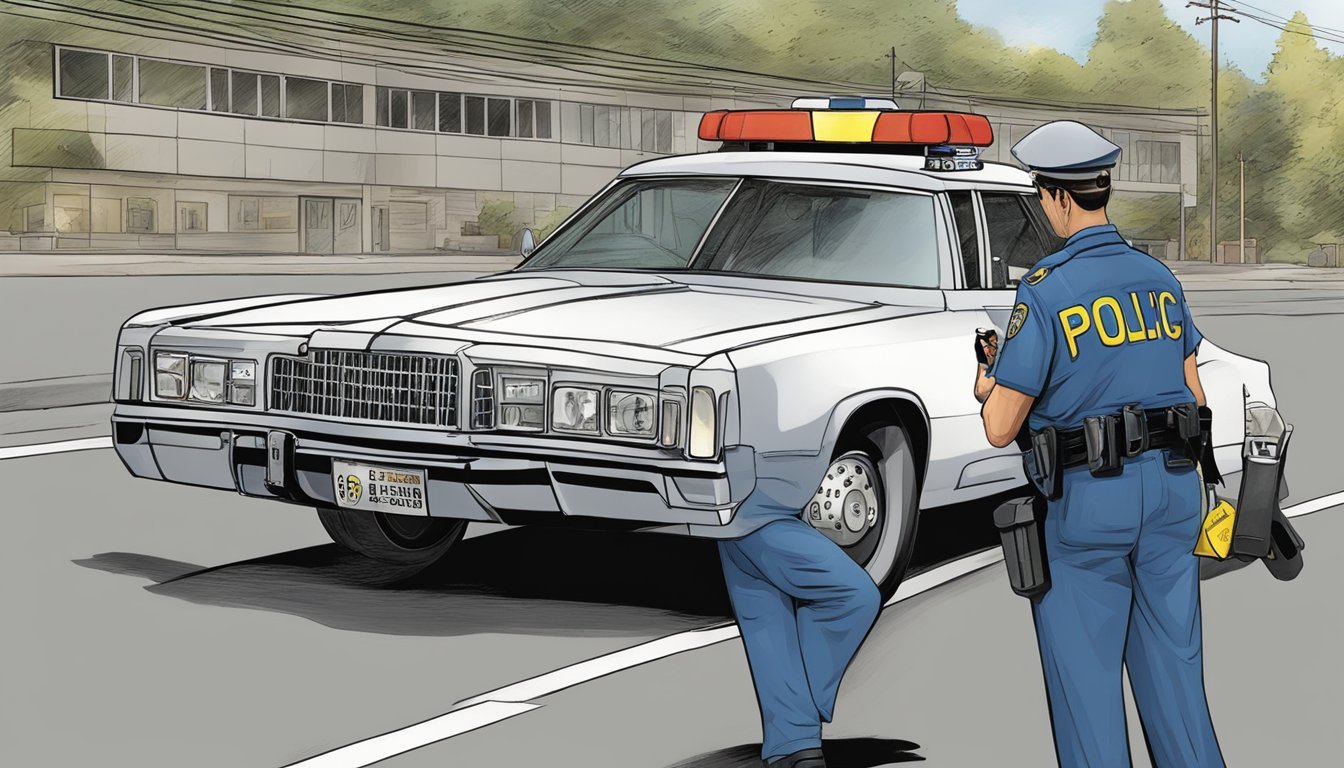Smiley Face Killer: Keith Hunter Jesperson's Highway of Tears
A Trucker's Deadly Cross-Country Rampage
Keith Hunter Jesperson terrorized the United States in the early 1990s, earning the moniker "Happy Face Killer" for the sinister smiley faces he drew on letters to the media and authorities. Born on April 6, 1955, in British Columbia, Canada, Jesperson later moved to the U.S. where he embarked on a deadly cross-country killing spree.
Jesperson confessed to murdering at least eight women across multiple states, including Florida, California, Oregon, Wyoming, and Washington. His victims were often sex workers and transients, making their disappearances difficult to track. The long-haul trucker used the vast network of highways as his hunting ground, leaving a trail of bodies in his wake.
The killer's reign of terror came to an end in 1995 with the murder of Julie Winningham. This crime set off a chain of events that led to Jesperson's capture and eventual conviction. He is currently serving multiple life sentences for his crimes, though he claims to have committed far more murders than those proven in court.
Keith Hunter Jesperson: Origins and Early Life
Keith Hunter Jesperson entered the world on April 6, 1955, in British Columbia, Canada. His early years were marked by instability and trauma that would shape his future path.
Formative Years
Jesperson grew up in a turbulent household. His father, Les Jesperson, was physically and emotionally abusive. Keith endured frequent beatings and harsh discipline from a young age.
The family moved often, living in various parts of British Columbia and Washington state. This transient lifestyle made it difficult for Keith to form lasting friendships or connections.
As a child, Jesperson exhibited concerning behaviors. He tortured and killed small animals, a common trait among future violent offenders. He also struggled socially and was often bullied by peers.
Jesperson's large size set him apart from other children. By age 14, he stood over 6 feet tall and weighed more than 200 pounds. This physical stature would later aid him in overpowering victims.
His teen years brought more upheaval. Keith dropped out of high school and left home at 16, eager to escape his father's abuse. He began working as a truck driver, a profession that would facilitate his future crimes.
The Emergence of the 'Happy Face Killer'
Keith Hunter Jesperson's sinister transformation into the 'Happy Face Killer' began in the early 1990s. His crimes shocked the United States and left a trail of victims across multiple states.
First Known Murder
Taunja Bennett became Jesperson's first confirmed victim on January 21, 1990, in Portland, Oregon. He met the 23-year-old at a bar and later strangled her at his home. Jesperson then dumped Bennett's body along the Old Scenic Highway.
This murder marked the start of his killing spree. Jesperson initially kept quiet about his involvement. Two other individuals were wrongly convicted of Bennett's murder, further complicating the case.
Pattern of Crimes
Jesperson targeted vulnerable women, often sex workers or transients. He used his job as a long-haul truck driver to find victims across state lines.
His modus operandi typically involved:
Strangling victims with his bare hands
Assaulting them sexually
Disposing of bodies in remote areas
Jesperson killed at least eight women between 1990 and 1995. He taunted authorities by sending letters to media outlets, signing them with a smiley face. This signature earned him the moniker 'Happy Face Killer'.
Victims and Their Stories
Keith Hunter Jesperson left a trail of tragedy across multiple states. His victims included both identified women and those who remain nameless to this day.
Identified Victims
Taunja Bennett, 21, was Jesperson's first known victim. He met her at a bar in Portland, Oregon on January 21, 1990. Jesperson took Bennett to his rental property, where he beat, raped, and strangled her.
Julie Winningham, 41, became Jesperson's final victim before his arrest. He murdered her in March 1995 in Washougal, Washington.
Angela Subrize, 23, was killed in January 1995. Jesperson met her at a truck stop in Spokane, Washington.
Unidentified Victims
A woman known as "Claudia" was murdered in August 1992 near Blythe, California. Jesperson described her as a sex worker he picked up.
Another unidentified victim was found in September 1994 near Crestview, Florida. Jesperson claimed she was a hitchhiker he strangled.
An unknown woman's body was discovered in July 1993 in Gilliam County, Oregon. Jesperson confessed to her murder but never provided her name.
Investigators continue working to identify Jesperson's unnamed victims and bring closure to their families.
Investigation and Arrest
Keith Hunter Jesperson's killing spree came to an end through a combination of investigative breakthroughs and his own actions. Law enforcement agencies across multiple states worked tirelessly to connect the dots and bring the elusive killer to justice.
Breaking the Case
Jesperson's crimes initially baffled investigators due to their geographic spread. His long-haul trucking job allowed him to commit murders across state lines, making it difficult to link the cases. The breakthrough came when Jesperson began sending confession letters to media outlets and law enforcement.
These letters, signed with a smiley face, earned him the moniker "Happy Face Killer." The confessions provided crucial details about the murders, helping police connect previously unrelated cases. Jesperson's downfall was accelerated by his arrest for the murder of Julie Winningham in 1995.
Forensic Breakthroughs
Advances in forensic technology played a key role in building the case against Jesperson. DNA evidence collected from crime scenes was analyzed and matched to samples obtained from the suspect. This scientific evidence corroborated Jesperson's confessions and strengthened the prosecution's case.
Investigators also employed forensic genetic genealogy to identify some of Jesperson's previously unknown victims. This technique allowed them to put names to unidentified remains, bringing closure to families and adding charges to Jesperson's criminal record.
The case took an unexpected turn when Laverne Pavlinac and John Sosnovske were wrongly convicted of one of Jesperson's murders. Their exoneration came after Jesperson's arrest and confession, highlighting the importance of thorough investigations and the potential pitfalls of false confessions.
Trial and Conviction
Keith Hunter Jesperson faced multiple trials across several states for his heinous crimes. His convictions led to life sentences in various correctional facilities.
Court Proceedings
Jesperson's legal battles unfolded in Oregon, California, and Florida. In Oregon, he stood trial for the murder of Julie Winningham. The prosecution presented compelling evidence, including Jesperson's own confessions and DNA matches.
California authorities charged him with the murder of an unidentified woman found in Riverside County. This case highlighted the challenges of prosecuting crimes against unnamed victims.
In Florida, Jesperson faced charges for killing Suzanne Steamboat in Okaloosa County. The trial brought closure to a long-unsolved case and shed light on his cross-country killing spree.
Sentencing
Oregon courts sentenced Jesperson to life without parole at Oregon State Penitentiary. This sentence effectively ended his freedom and marked the beginning of his incarceration.
California imposed another life sentence for the Riverside County murder. The judge emphasized the brutality of Jesperson's crimes in delivering the verdict.
In Florida, Jesperson received a life sentence for second-degree murder. This ruling ensured he would never be released, regardless of potential parole decisions in other states.
The combined sentences guarantee Jesperson will spend the rest of his life behind bars, providing some measure of justice for his victims and their families.
Criminal Profiling of Jesperson
Keith Hunter Jesperson, known as the "Happy Face Killer," exhibited distinct psychological traits and behavioral patterns. His crimes were characterized by a unique signature and method of operation that provide insight into his mindset and motivations.
Psychology Behind the Crimes
Jesperson displayed traits consistent with antisocial personality disorder and psychopathy. He lacked empathy for his victims and showed no remorse for his actions. His childhood experiences of abuse and neglect likely contributed to his violent tendencies.
Jesperson's need for attention and recognition drove him to taunt authorities with letters signed with smiley faces. This behavior indicated a desire for notoriety and control over the investigation.
His occupation as a long-haul truck driver provided opportunities to commit crimes across multiple states, making detection more challenging.
Signature and Modus Operandi
Jesperson's signature included strangling his victims with items like zip ties or his bare hands. He often targeted vulnerable women, including sex workers and hitchhikers.
His modus operandi involved:
Picking up victims at truck stops or along highways
Using his physical strength to overpower them
Disposing of bodies in remote locations
The smiley face signatures on his letters to media and law enforcement became his trademark. This unique identifier ultimately led to his capture and conviction.
Jesperson's crimes spanned multiple states, creating jurisdictional challenges for investigators. His ability to move frequently made establishing a pattern of his activities difficult until he began communicating with authorities.
The Role of Technology in Cold Case Resolution
Advancements in technology have revolutionized cold case investigations, providing new tools to identify victims and solve decades-old crimes. DNA analysis and national databases have become crucial in cracking previously unsolvable cases.
DNA Technology's Impact
DNA technology has transformed cold case investigations. Genetic genealogy techniques now allow investigators to identify victims and suspects using DNA profiles from crime scenes. This method was instrumental in the "Happy Face Killer" case, bringing investigators closer to identifying Keith Hunter Jesperson's last unidentified victim.
Law enforcement agencies can upload DNA profiles to databases like GEDmatch, comparing them against millions of genetic profiles. This process can reveal familial connections, narrowing down potential identities. In Riverside County, cold case teams have leveraged these advancements to make significant progress in identifying "Claudia," Jesperson's unidentified victim from 1992.
National Databases and Systems
The National Missing and Unidentified Persons System (NamUs) plays a vital role in cold case resolution. This centralized database allows law enforcement agencies to share information about missing persons and unidentified remains across jurisdictions.
NamUs combines case details, physical descriptions, and DNA profiles, facilitating matches between missing persons reports and unidentified remains. This system has proven invaluable in connecting the dots in complex cases spanning multiple states, like those involving long-haul truck drivers such as Jesperson.
The integration of various national databases enhances investigators' ability to cross-reference information and identify patterns across seemingly unrelated cases.
Keith Jesperson's Impact Beyond the Crimes
Keith Jesperson's actions reverberated far beyond his immediate victims. His case profoundly affected true crime media and left lasting scars on victims' families.
Media and True Crime Genre
Jesperson's crimes and unique "happy face" signature captivated public attention. His case spawned numerous books, documentaries, and television adaptations. The 2014 TV film "Happy Face Killer" starring David Arquette brought Jesperson's story to a wider audience.
True crime podcasts and series frequently feature the Happy Face Killer case. These media portrayals often explore Jesperson's psychology and the investigative challenges authorities faced in catching him.
The extensive coverage of Jesperson's crimes contributed to the growing popularity of the true crime genre in the 1990s and early 2000s.
Long-Term Effects on Victims' Families
The families of Jesperson's victims continue to grapple with trauma and loss decades later. Many struggle with unresolved grief, as some victims remained unidentified for years.
Support groups have formed to help these families cope with their shared experiences. Some relatives have become advocates for victims' rights and improved methods of identifying missing persons.
The prolonged nature of Jesperson's killing spree and his taunting letters to the media compounded the pain for many families. His actions left a legacy of fear and mistrust, particularly among vulnerable populations targeted by Jesperson.
Geographical Context of the Murders
Keith Hunter Jesperson's crimes spanned multiple states and provinces across North America. His long-haul trucking career provided opportunities to commit murders in various locations along major highways.
Regional Analysis of Crime Scenes
Jesperson's murders occurred primarily in the western United States and Canada. He committed killings in Washington, Oregon, California, Wyoming, and Nebraska. Some victims were also found in Florida and British Columbia.
The I-5 corridor in the Pacific Northwest was a frequent route for Jesperson. He often targeted vulnerable individuals at truck stops and rest areas along this highway. In Oregon, he murdered women near Portland and in rural areas.
California saw multiple victims, with bodies discovered near Interstate 10. Wyoming and Nebraska each had confirmed murders linked to Jesperson's cross-country travels.
Highway of Tears Connection
The "Highway of Tears" in British Columbia gained notoriety for numerous unsolved murders and disappearances of women. While Jesperson was not directly linked to most cases on this highway, his crimes shared similarities.
Like the Highway of Tears cases, Jesperson targeted women along remote stretches of road. His victims were often transient or engaged in high-risk lifestyles. The vast distances between crime scenes complicated investigations.
Jesperson's activities in British Columbia raised questions about potential connections to unsolved cases in the region. However, conclusive links to specific Highway of Tears disappearances remain elusive.






